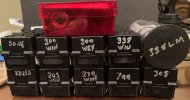I know this is going to start the age old battle of crimp or not to crimp and that's not what I'm trying to do so I'm stating "This is why I crimp", This is my opinion so take it for that, I'm just sharing my personal experience and what works for me I am not a competition shooter nor do I claim to be Just a LRH . This is the second time this has happened to me in the past thirty years, the first was an Elk hunt in Oregon where I mailed my rifle and ammo out and then spent a week Horseback and the second time was yesterday, I will tell you that I do not abuse my guns, with that being said I use them for what they are intended for and I do not own anything that hasn't been "Well Used" No safe queens here, Now why I crimp, My Coyote Rig is a Rem 700 in 270 with 90 gr Sierra's, I loaded some rounds last month and got sidetracked and didn't crimp ( I use the Lee FCD on everything I load ) 10 rounds, I just let it go cause I wanted to get in the woods,these were loaded into a 5 rd Magazine two weeks ago, i hunt every evening an twice a day on the weekends 2 to 3 sets a trip and last Saturday my gun slipped off of my shoulder and landed on the Butt stock in a field and didn't hurt anything, fast forward to last night, I shot a ground hog ejected and chambered a new round and while unloading the weapon i saw the bullet in the second round in the mag was gone, upon examination I found the bullet had fell back in to the case, as i said this is the second time this has happened to me and why " I crimp" As for a side note this was 3X fired brass annealed, trimmed and FL resized every loading with a measured .0023 neck tension

